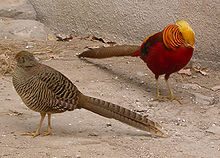Collared Pheasants
| Collared Pheasants | ||||||||||
|---|---|---|---|---|---|---|---|---|---|---|

Rooster of the diamond pheasant |
||||||||||
| Systematics | ||||||||||
|
||||||||||
| Scientific name | ||||||||||
| Chrysolophus | ||||||||||
| JE Gray , 1834 |
The frilled pheasants ( Chrysolophus ) are a genus within the pheasant-like family . There are only two monotypical species of this genus, both of which are native to East Asia and there mainly in China . The golden pheasant occurs in central China to western Sichuan , the distribution of the diamond pheasant extends from there to Tibet and Myanmar . In the triangle of the Chinese provinces of Sichuan, Yunnan and Guizhou , the occurrence of the two species overlaps and hybrids sometimes occur here . The close relationship of the two species is also shown by the fact that they are very easy to cross in captivity. In the first generation of such crosses, both species are usually fertile. Both species and especially the golden pheasant are often kept in captivity.
description
Both species of the genus are relatively delicate, very long-tailed pheasants. The unmistakable roosters are among the most colorful pheasants and wear a typical collar made of elongated, very wide feathers on the sides of their heads and in the neck, which can be spread out in the form of shields during courtship activities. The collar feathers of the golden pheasant are almost angular, the diamond pheasant is clearly rounded at the bottom. In both species they have wide, dark hems. In contrast to other pheasant species, the featherless eye area is not red, not very extensive and does not have any erectable lobes. On the top of the head, the long, hard and shiny feathers form a hood that falls down to the neck. The tail, which is roof-shaped and strongly stepped in cross-section, consists of eight pairs of control springs , the middle of which is greatly elongated. The diamond pheasant can reach a length of up to 1.15 m. The featherless legs are long and slender, the spurs are only slightly pronounced. The hens have a relatively plain brown plumage, which is quite regular black stripes. In the hen of the golden pheasant, the basic tint is more yellow-brown, in that of the diamond pheasant it is more red-brown. In both species, the eggs are very large compared to their body size.
Way of life
Both species live in subtropical mountain jungles and forests, with the golden pheasant up to 2500 m altitude, the diamond pheasant preferentially in higher and sometimes colder locations. In the area of common distribution, however, they also occur in the same habitats. In contrast to the golden pheasant, in which winter groups only consist of up to three birds and in which couples often stay to themselves all year round, in the diamond pheasant groups of several families and up to 20 or 30 birds are formed. There are clear differences to other pheasants and especially to the genus Phasianus , especially in behavior. Both frilled pheasants live in monogyny . The courtship is very characteristic: the head is lowered with stretched legs and the tail upright, and above all the spread collar and the colored back areas are presented.
species
- Golden pheasant ( Chrysolophus pictus )
- Diamond Pheasant ( Chrysolophus amherstiae )
supporting documents
literature
- Heinz-Sigurd Raethel : Chicken birds of the world. Verlag J. Neumann-Neudamm GmbH & Co. KG, Melsungen 1988, ISBN 3-7888-0440-8 .
- Steve Madge , Phil McGowan, and Guy M. Kirwan : Pheasants, Partridges and Grouse. Christopher Helm, London 2002, ISBN 0-7136-3966-0 .

